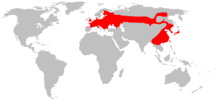Eurasian harvest mouse
| Eurasian harvest mouse | |
|---|---|
 |
|
| Scientific classification | |
| Kingdom: | Animalia |
| Phylum: | Chordata |
| Class: | Mammalia |
| Order: | Rodentia |
| Family: | Muridae |
| Subfamily: | Murinae |
| Genus: | Micromys |
| Species: | M. minutus |
| Binomial name | |
|
Micromys minutus (Pallas, 1771) |
|
 |
|
| Distribution of harvest mice | |
The harvest mouse (Micromys minutus) is a small rodent native to Europe and Asia. It is typically found in fields of cereal crops, such as wheat and oats, in reed beds and in other tall ground vegetation, such as long grass and hedgerows. It has reddish-brown fur with white underparts and a naked, highly prehensile tail, which it uses for climbing. It is the smallest European rodent; an adult may weigh as little as 4 grams (0.14 oz). It eats chiefly seeds and insects, but also nectar and fruit. Breeding nests are spherical constructions carefully woven from grass and attached to stems well above the ground.
Before the harvest mouse had been formally described, Gilbert White believed they were an undescribed species, and reported their nests in Selborne, Hampshire:
They never enter into houses; are carried into ricks and barns with the sheaves; abound in harvest; and build their nests amidst the straws of the corn above the ground, and sometimes in thistles. They breed as many as eight at a litter, in a little round nest composed of the blades or grass or wheat. One of these nests I procured this autumn, most artificially platted, and composed of the blades of wheat; perfectly round, and about the size of a cricket-ball. It was so compact and well-filled, that it would roll across the table without being discomposed, though it contained eight little mice that were naked and blind.
Conservation efforts have taken place in Britain since 2001. Tennis balls used in play at Wimbledon have been recycled to create artificial nests for harvest mice in an attempt to help the species avoid predation and recover from near-threatened status.
...
Wikipedia

